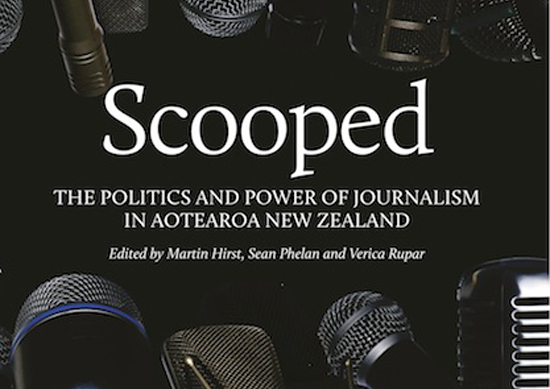
BOOK REVIEW: Scooped can be appreciated for what it is: a thorough academic, sometimes theoretical canvas of many aspects of New Zealand journalism. It is not a perfect account, but it is an important one—and long overdue.
Scooped: The politics and power of journalism in Aotearoa New Zealand, edited by Martin Hirst, Sean Phelan and Verica Rupar. Auckland: AUT Media, 2012. 232 pp. ISBN 9780958299763
Scooped, the latest academic attempt to snapshot New Zealand journalism, is mouth-wateringly proffered as having grown out of the much-talked about—and talked about—disconnect between academe and industry.
Editors Hirst, Phelan and Rupar portray the relationship as a ‘power struggle’ between vocational and academic perspectives. Though unstated, this approach seems to have been triggered by several prominent attacks and spats of the last couple of years.
Notable have been strident criticism by columnist Chris Trotter of journalism training in our universities, a volatile Media 7 panel discussion and, most recently, a war of words between journalist and columnist Karl du Fresne and academic Phelan. Each case highlighted industry unease with what it saw as a university preoccupation with theory over craft, with a corollary implication that today’s university-trained reporters don’t measure up to their Golden Age predecessors.
This war has been no one-way street. Anyone who has trod academic hallways will be aware of a common disdain for the performance and product of today’s news media. In the book’s preface, Massey University Vice-Chancellor Steve Maharey notes rather obviously that the struggle has at times been acrimonious. He also says that the editors believe it is time to move on.
Easier said than done? But Maharey’s is a brilliant gauntlet to kick off a long overdue exercise in journalistic navel-gazing. Not since McGregor and Comrie’s What’s News? has a homegrown audience had access to such a gamut of journalism issues and scholarly debate. Scooped contains much useful and thought-provoking material, even if this mostly academic fare is unlikely to put industry worriers at ease.
Chapters, of course, are not all framed around the above debate, but include many references sure to spark discussion. The editors’ introduction, for instance, includes: “The discrepancy between the journalistic ideals of providing context and background to a story, and the reality, where journalists produce stories around ‘rent-a-quote’ sources… (p. 19)”.
This casual claim of the reality is, at the very least, questionable, and should have been supported with argument. Self-proclaimed Marxist Hirst, in his chapter on the cultural politics of journalism, may annoy journalists, if only for the extent of his departure from the plain English beloved of practitioners. But I actually loved Hirst’s identification of journalists as proletariat—I was surprised he didn’t devolve them further as lumpenproletarian. The ‘common-man’ aspirations of journalism go to the very heart of the disconnect.
Plain English brigade
Without attempting to do justice to all chapters, I would recommend Phelan’s discussion of media power and agency, though he too may fall foul of the plain English brigade. Phelan’s chapter, though without resolution, is important for attempting to move beyond the simple ‘fourth estate’ model in the new digital environment. Thompson’s chapter on public broadcasting is similarly welcome for leading students and scholars beyond the doddery ‘four theories of the press’, as well as Galtung’s forever-quoted and amended typology of news values.
Likely to carry more currency with journalists and journalism students, will be the Comrie chapter on politics and power—a study of power manipulations based on actual events and participant interviews—and Pamatatau’s moving account of the vicissitudes—and at times racism—encountered working in the media as a Pacific Islander. “It is great to have you on board as our first Pacific Issues correspondent,” he was greeted when he joined Radio NZ. “But we thought you would be darker (p. 183)”. There is nothing so potent as a personal story.
Other chapters likely to resonate are Gajevic’s ‘traitor’ case study of Russell Coutt’s departure from New Zealand’s America’s Cup team, Manning’s examination of the electronic public sphere, largely via his experience with groundbreaking website Scoop, and Macdonald’s canvas of the politics and voice of the NZ Listener. Hope has written usefully on the public sphere; Abel, McCreanor and Moewaka Barnes on reporting Te Tiriti (Treaty of Waitangi); and Matheson makes some interesting international reporting comparisons.
Investigative reporter Hager—famously and unfairly decried by the Dominion Post as ‘not a real journalist’—closes with suggestions of how journalism can combat the growing tentacles of PR, over-commercialisation, as well as deal with the challenges of the internet. He is at his most powerful, however, on how investigation can survive in a resource-lacking world, concluding: ‘The common feature of investigative journalists is not their institutional backing but rather their strong personal motivation and sense of vocation (p. 227)’.
Which may explain why our investigative reporters can be counted on one hand!
Journalism education
The chapter that intrigued me most, however, was Thomas’s on journalism education. From a base of empirical testing, Thomas calls for an opening-up of teaching beyond the narrow skills traditionally required of journalists. Red rag to an industry bull? Before running to the bull-gate, it should be noted she does not reject traditional training, just urges a broadening. The two approaches are not—both sides might be reminded—mutually exclusive.
And with that realisation, this book can be appreciated for what it is: a thorough academic, sometimes theoretical canvas of many aspects of New Zealand journalism. It is not a perfect account, but it is an important one—and long overdue.
References
McGregor, J., & Comrie, M. (Eds.) (2002). What's news?: Reclaiming Journalism in New Zealand. Palmerston North: Dunmore.
This work is licensed under a Creative Commons Attribution-NonCommercial 3.0 New Zealand Licence.




